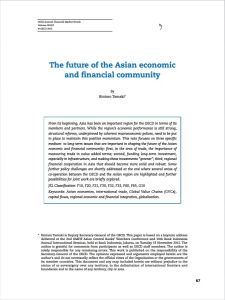Join getAbstract to access the summary!

Join getAbstract to access the summary!
Rintaro Tamaki
Future of the Asian Economic and Financial Community
OECD, 2013
What's inside?
The future looks bright for Asian economies, but only if they carry out crucial reforms.
Recommendation
Asian economies have come through the financial crisis in relatively robust health and should grow solidly in the coming years. But to improve their chances of continued progress, individual nations need to execute “structural reforms.” Rintaro Tamaki, deputy secretary-general of the OECD, explains the challenges facing this dynamic region. Taken from Tamaki’s address to a conference of Asian central bankers, this technical paper is heavy on statistics. Although it doesn’t provide a country-by-country analysis, getAbstract recommends its solid information to investors, finance professionals, policy makers and leaders of businesses operating in Asia.
Summary
About the Author
Rintaro Tamaki is deputy secretary-general of the OECD. He leads OECD policy on environment, development, green growth, financial affairs and taxes.

















Comment on this summary